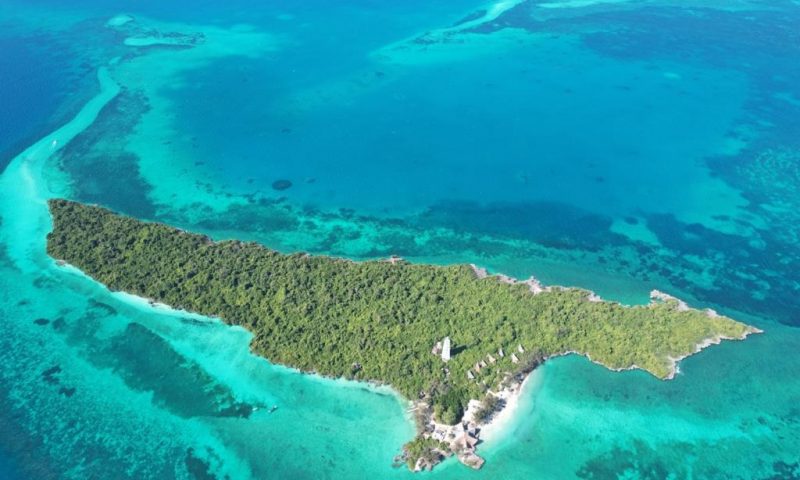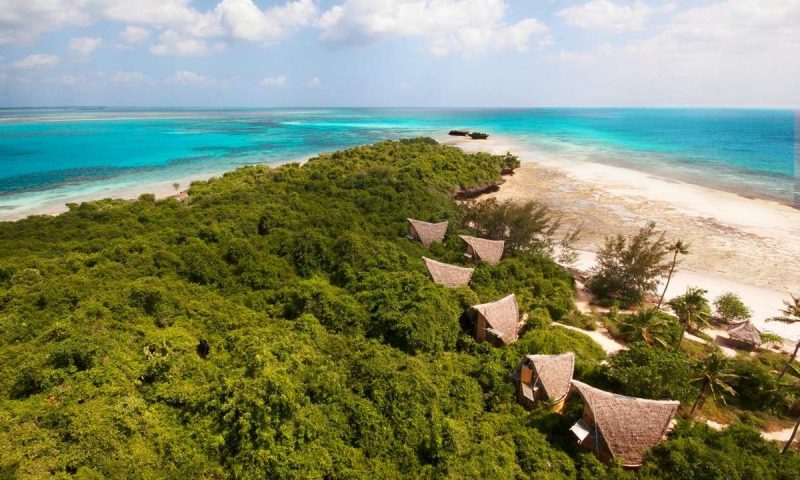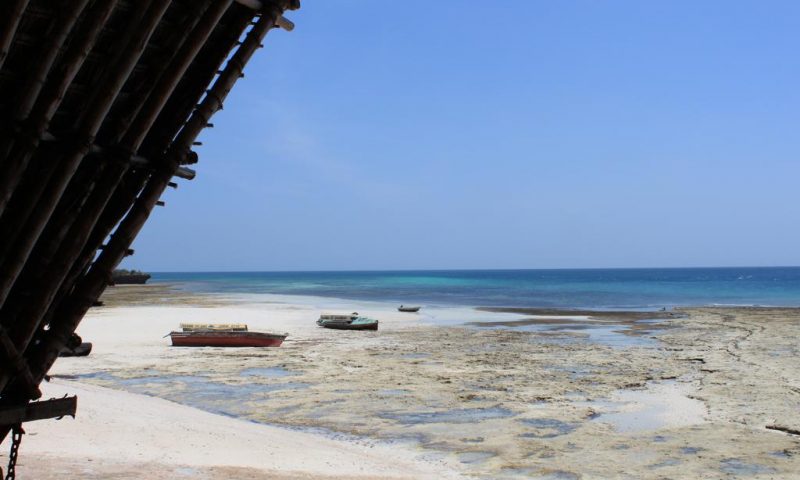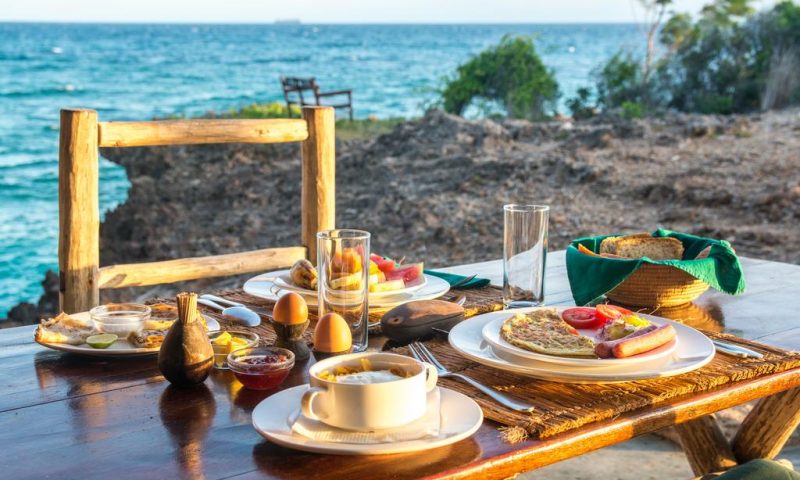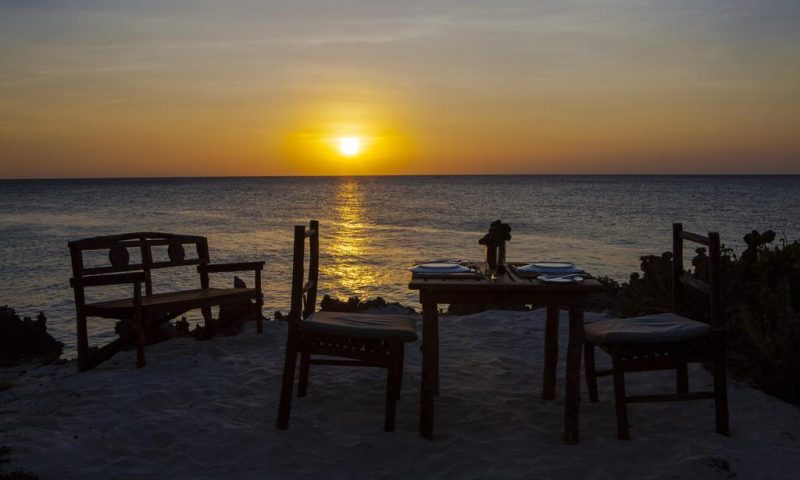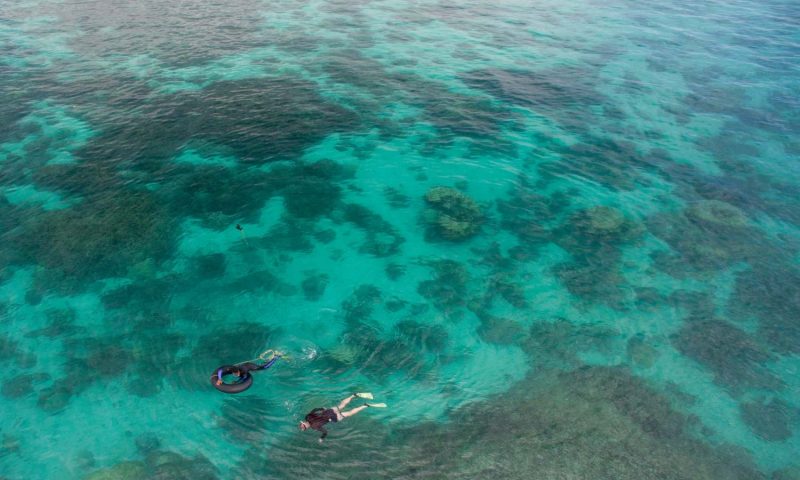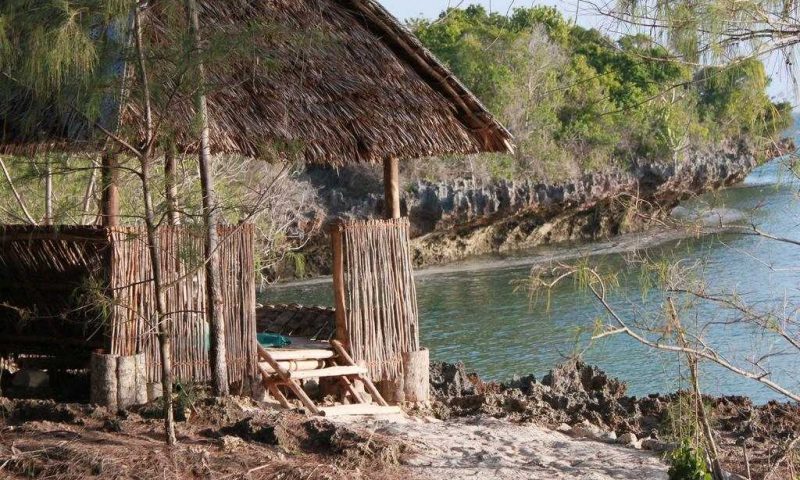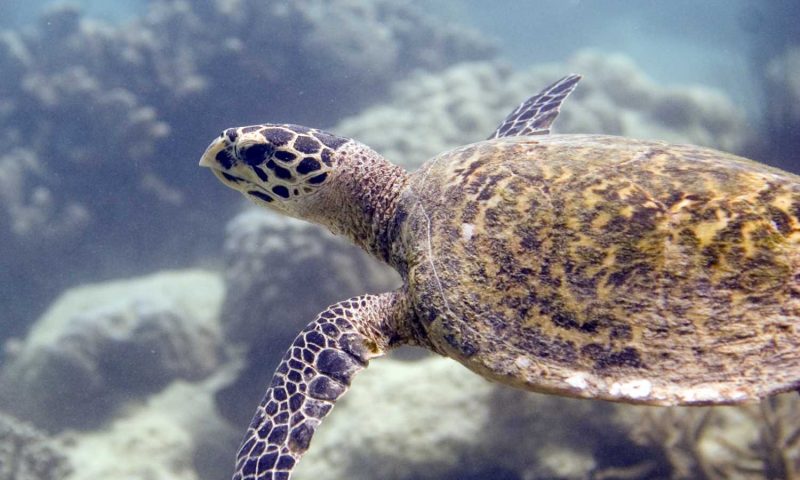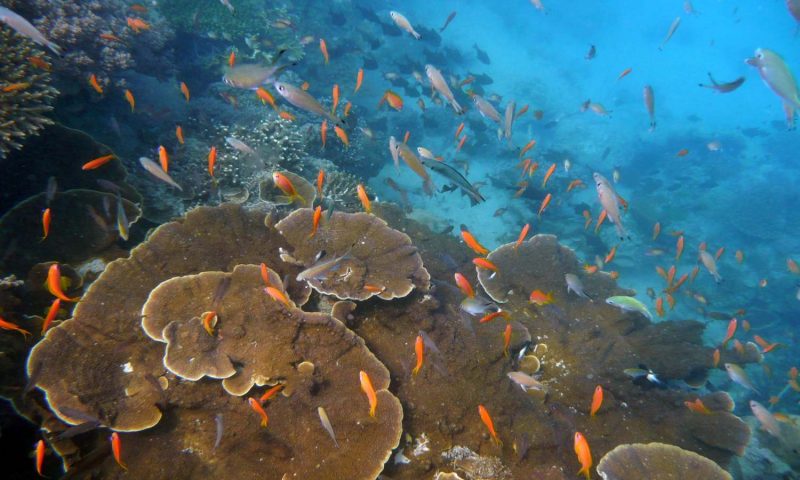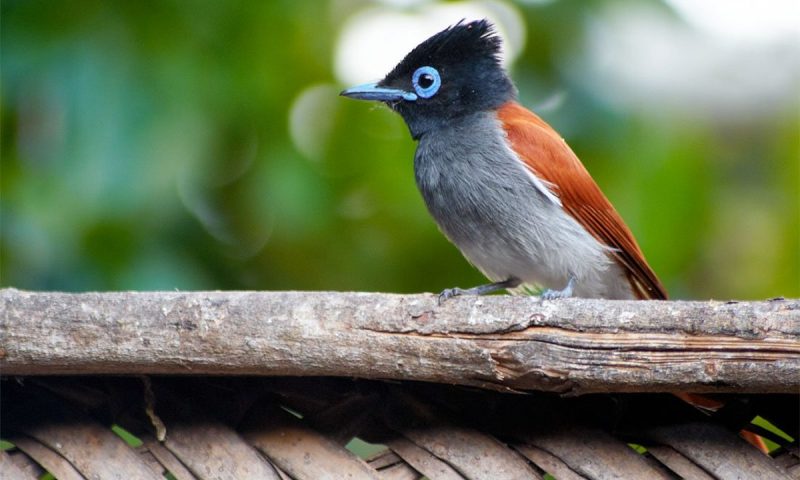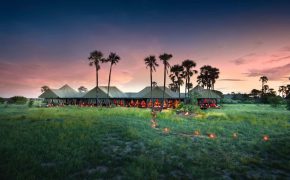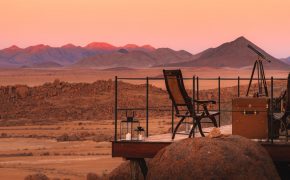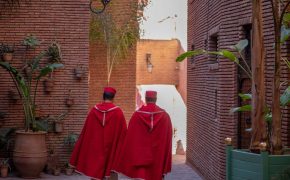Chumbe Island is an idyllic tropical island that is situated about 6 km west of the larger island of Zanzibar and about 30 km off the coast of Tanzania in East Africa. A 45-minute boat ride takes you to this small, magical island where hospitality is not just a way of business, but a way of life!
Explore the island’s coral reef sancutary and coral rag forest, rest assured in our exclusive eco-bungalows, savor traditional Zanzibari cuisine while supporting our conservation and education efforts!
PROJECT HISTORY
In the early 1990’s Sibylle Riedmiller, a former overseas development worker, identified the uninhabited Chumbe Island as most suitable for the establishment of a marine protected area (MPA), as the western fringing coral reef was incredibly diverse and also shallow enough to be used for environmental educational programs.
Traditionally, the sea surrounding the island was a military area where the army routinely conducted shooting range exercises from the adjacent coast.
Fishing was also restricted as small fishing boats would have obstructed vessels plying the shipping channel to Dar es Salaam, and in addition, few boatmen could then afford outboard engines to reach this most distant of the islets surrounding Zanzibar town.
As no local resource users were to be displaced, conditions appeared ideal for the creation of a MPA that depended on co-operation with local fishers rather than government enforcement.
From 1991 to 1994, Chumbe Island Coral Park Limited (CHICOP) successfully negotiated with the semi-autonomous government of Zanzibar that the western coral reef and all forest cover of Chumbe Island to be gazetted as a MPA.
This MPA would be managed by CHICOP, a limited company established for that purpose, becoming the first managed marine park in Tanzania and what is considered to be the first private MPA in the world.
Ecotourism operations started in 1998 with the intention to develop a financially sustainable model of MPA management through revenue generated from ecotourism. Since then CHICOP has become the first financially self-sustaining MPA in Africa and beyond.
ACCOMMODATION
Accommodation on Chumbe Island is – in many aspects – something really special. It’s what Robinson Crusoe could only have dreamt about!
The island’s accommodation and guest lodge are constructed with state-of-the-art, environmentally friendly architecture and are designed to have near zero impact on the environment.
The technology includes rainwater catchment, photovoltaic energy, solar water heating, composting toilets and vegetative greywater filtration. Hence, during your stay you can rest assured that you are keeping the island pristine.
Since there are only seven bungalows, the island never gets crowded, even when we are fully booked. Our bungalows are so brilliantly designed that they provide both privacy and a sense of freedom of living in the open.
All bungalows overlook the sea and it takes just 30 seconds to stroll from the comforts of your bungalow hammock to feeling the warm tropical ocean lapping at your feet.
ECO-BUNGALOWS
You will be accommodated in one of our 7 stunning eco-bungalows, perfectly blended with the surrounding nature and situated between the beach and the forest.
Each bungalow is equipped with queen-size beds in the sleeping area under the palm thatched roof, a self-contained bathroom (with shower, wash basin and composting toilet), a large living room equipped with handmade furniture and decorated with African art, colorful fabrics, and a very comfortable bed-style hammock.
Take your time to explore our eco bungalows and see for yourself what’s so special about them:
Rainwater harvesting
As there is no ground water source in the rocky substrate of the island, each bungalow collects its own freshwater supply from rainwater during the rainy season. This rainwater passes through a complex filtration system and is stored in spacious underground cisterns.
The water is then hand-pumped through a solar-powered heating system into hot & cold-water containers for the shower and hand basin in the bathroom. Water is accessed through standard plumbing fixtures.
Composting Toilets
Our compost toilets decompose human waste quickly and reduce it to a nutrient rich dry matter that is re-used in toilets and plant beds.
The aerobic composting process is powered by a ventilation system of small wind-wheels fitted on top of long ventilation pipes and ensures our guests that it feels not different to using a regular toilet; except that composting toilets need no flush water at all, thus they effectively economize on water and prevent sewage from entering the reef where it would negatively affect the highly sensitive coral community.
Solar Power
Lights are powered by photovoltaic panels on the roof that provide ample environmentally friendly 12V energy for normal usage.
The open design of the bungalows, with minimal barriers to the open air, allows for maximum through-draft for cooling of the bungalows; a form of natural air-conditioning. To enhance this louvers are in place that can be lowered or closed depending on the desired temperature.
CUISINE
Dining takes place in open-air terraces overlooking the Indian Ocean in the afternoon, and under palm trees and stars in the evening. Our talented chefs prepare mouthwatering dishes that are a mixture of Zanzibarian, Arabic, Indian and African cuisine.
Fresh, local seafood, meat, vegetables, and fruits are used to create some of the most delicious dishes on Zanzibar which satisfy both vegetarians and non-vegetarians.
CHICOP purchases only fresh fish from local fishers and has implemented a seafood purchasing policy, endeavoring to purchase pelagic fish species that are neither threatened nor caught in shallow coral reefs through unsustainable fishing techniques.
“A Sustainable Seafood Guide” has been developed to help our decision making and raise awareness among our guests and suppliers. Please inform us during your booking about any specific dietary needs or special meal preferences, as our chefs are happy to make the necessary arrangements and cater to your needs.
Chumbe Island’s best Zanzibari recipes have been compiled to a small cook book that is available in our Island Boutique. It is our hope that these recipes spice up your home cuisine and bring back fresh, flavorful memories of your time on Chumbe Island.
ACTIVITIES
Lots of activities are waiting for you on and around Chumbe Island – make sure you bring enough time with you! The whole of Chumbe Island is a nature reserve and you may explore its beauty either under the competent guidance of our experienced rangers or at your leisure.
All guided activities are included in your stay and scheduled daily, according to the prevalent tides to ensure snorkelling is conducted when tide conditions are optimal.
Snorkel through our unique shallow water Coral Reef Sanctuary, join guided nature walks and gaze at historical monuments. Or just allow yourself a lazy day watching dhows and outrigger boats going by.
SNORKELING
Our guided snorkeling tour takes you by boat to the edge of our Coral Reef Sanctuary where the view opens up a world of breath taking sights. Each snorkeling tour lasts for about one hour and provides new discoveries for our guests.
With each visit you are unlikely to be disappointed! No matter if you are a snorkeling newcomer or professional, our competent guides will make you sure you get the most out of it in a safe and responsible way.
If you decide to explore the reef on your own, please make sure to check the tide table with our rangers in advance and please follow the internationally recognized UNEP/Green fins code of conduct to ensure safety for yourself and protection of the delicate coral reef.
What is special about Chumbe’s coral reef?
The Chumbe coral reef is a protected sanctuary which is famous for its coral diversity, holding 90% of the coral diversity found in East Africa. About 200 species of hard corals have been recognized by coral taxonomist Prof.
Veron from the Australian Institute of Marine Sciences. These corals act like trees in a forest: they provide home, shelter and food for an impressive number of over 440 identified fish species.
With negligible fishing intrusion for so many years, our marine wildlife has become unconcerned about those few humans moving around and include for example:
- Batfish that have developed the habit of following snorkelers at close range all along the reef
- Lobsters peeping out from under corals, trying to investigate your presence with their long white feelers
- Bluespotted stingrays, almost invisible when hiding under a thin layer of sand
- Oscar, a potato grouper more than 1m in size, living in one of the caves at the drop off
- Large, colourful parrotfish nibbling on algae overgrown corals with a very audible scratching sound
- Hawksbill turtles resting and feeding in the reef
Many more species are waiting to be discovered and most common fish along with other reef species are now displayed in Chumbe’s unique photo-guide which was developed by a family that has been returning to Chumbe Island for over 10 years.
Countless hours snorkeling in the Chumbe Reef, subsequent identification with the Chumbe Conservation Team and tireless editing back home in Germany resulted in this impressive guide which has become the most popular guidebook among our guests.
A digital copy of the photo guides is now also available on our download page. All of these treasures can be seen by snorkeling through this protected shallow coral refuge.
And while SCUBA diving within the Chumbe Reef Sanctuary is not permitted (except for research and filming activities), it is still possible to enjoy diving on the nearby reefs. Please check with our reservations department for details during your booking.
COCONUT CRAB WALK
After dinner, our overnight guests have the chance to encounter giant Coconut crabs in the coral rag forest. Coconut crabs can reach up to 45 cm in diameter and are the larget living land crabs in the world!
During daytime they hide in caves and crevices but after sunset they roam around to look out for food. Although coconuts are their prefered diet, they are scanvengers and eat almost everything they can find.
INTERTIDAL WALK
‘Intertidal’ refers to a shore area that is covered by seawater at high tide and exposed during low tide. On Chumbe Island, intertidal walks are only possible during spring low tides (at new and full moon), when the tide is low enough for our guests to explore rocky pools and seagrass meadows without having to snorkel or even swim.
Guided intertidal walks are led by our experienced rangers who are familiar with the shore, ensure safety and will show you fascinating marine organisms which are usually well camouflaged or hidden. When the tide is very low it is also possible to walk all the way around the island which takes a bit over one hour.
Upon reaching the north point of the island, you can then bask on the exposed sandbar providing over a kilometer of pristine beach, while at the south point you can walk to the small islets where you may be fortunate enough to see fish eagles battling for territory.
In addition to the intertidal walk, sailing around the island at sunset may be possible in our Chumbe Ngalawa (dependent on conditions and availability).
This small outrigger sailing boat is a traditional local fishing vessel in Zanzibar, and the sunset sail offers guests a unique experience, as well as providing spectacular views of the island.
JUST RELAX
The island has an array of secluded beach huts, sun loungers and swinging beds for you to relax and enjoy at leisure. Escape it all to the sounds of waves breaking on the beach and birds singing in the trees. On this private island, tranquility is assured.
A book exchange is also available in the Education Center, as well as a small selection of games, drawing materials and paper, and Chumbe Island educational materials and wildlife guides on commonly spotted birds, butterfly, fish, and more.
FOREST WALK
A trail circles the southern part of the dense coral rag forest on Chumbe Island. Venture this trail on your own or join our one hour guided forest walk where you learn more about the geology of the island, plant adaptations to survive without groundwater, medicinal uses of local trees and shrubs and hidden fauna that is difficult to spot. Explore:
- the footpath leading down into a large intertidal pool overgrown with mangroves and shaded by huge
- baobab trees, where the seawater rises and falls with the tides and where you may observe many creatures adapted to these conditions
- skeletal structures of corals and giant clams – a gentle reminder that Chumbe Island was once a thriving coral reef that became fossilized.
- Try to identify these 15,000 year old fossils in the rocky, lunar landscape on the eastern side of the island where salt sprays from the sea prevent vegetation from settling
- birds hiding in the thicket, hermit crabs crawling over leaves and lizards resting on the ground
HISTORICAL MONUMENTS
Chumbe Island has been uninhabited for many decades, but had historical buildings that were either left untouched or carefully restored by CHICOP.
Lighthouse
A historic lighthouse, built by the Sultan of Zanzibar and the British in 1904, provides spectacular views of the turquoise seas between Tanzania mainland and Zanzibar, still plied by dhows unchanged for a thousand years.
There are 132 steps to the top, and since 1926 it has been powered by an AGA gas mechanism which was replaced by a solar system in 2013.
The lighthouse falls under the jurisdiction of the Zanzibar Ports Corporation (ZPC) which ensures that it continues to function as an important and essential signal of shallow water to maritime users.
Mosque
The historic mosque on Chumbe Island is one of the few mosques of Indian architecture in Zanzibar, built for the Indian lighthouse keeper by their community at the turn of the century. It has been renovated using traditional techniques and is still used for daily prayers by our Muslim team members on the island.
Visitors’ Centre
The former lighthouse keepers’ house has been carefully restored and converted into our Visitors’ centre that harbours the restaurant and exhibits environmental information about the Chumbe nature reserve for all our visitors. A special classroom for our environmental education program was added in 2001.
LOCAL ARTISAN BOUTIQUE
A small boutique is located in our Visitors Center, selling locally made sustainable, fair trade products and Chumbe related memorabilia. This includes our much sought after Chumbe Cookbook and a range of community-produced handicrafts.
Sales of boutique items supports the small enterprises and local livelihoods of Chumbe’s neighboring villages and associated organizations, including Ushindi Women’s Group, Charles Dhow Wood, Adam Foya, and Aromas of Zanzibar.
CONSERVATION
Chumbe Island is a unique, privately managed nature reserve developed and managed by Chumbe Island Coral Park Ltd. (CHICOP). It is a rare example of a still pristine coral island ecosystem in an otherwise heavily overfished and overexploited area.
The nature reserve includes a Coral Reef Sanctuary, which has become the first gazetted marine park in Tanzania, and a Forest Reserve.
Chumbe is classified as a Category II protected area under IUCN’s WDPA listings where permitted uses include recreation (swimming, snorkeling, underwater photography), education and non-extractive research activities.
To establish the conservation value of the reserve, baseline surveys were conducted at the start of the project, and regular and thorough monitoring of the Chumbe marine and terrestrial ecosystems have since been carried out to ensure an adaptive management approach.
CORAL REEF SANCTUARY
The Coral Reef Sanctuary of Chumbe Island has a size of 55 hectare and is protected as a No-Take-Area where fishing and un-authorised anchoring are prohibited. Due to its protection the reef has remained in a pristine state and represents one of the most beautiful and diverse shallow reefs in the region.
It hosts 90% of East Africa’s hard coral species, over 400 reef fish species and is an important feeding ground for hawksbill and green turtles.
The reef crest, encompassing a spectacular array of hard corals, is shallow and snorkelers can see all those wonders of the underwater world which are normally only accessible to divers.
With Chumbe being located upstream of the most important fishing grounds opposite Zanzibar’s capital, Stonetown, the Coral Reef Sanctuary also provides a protected breeding ground for fish, corals and other species which spread out to recolonise nearby overfished and degraded areas.
This makes the Coral Reef Sanctuary of vital importance to both the preservation of biodiversity and the fisheries economy in the region.
The Chumbe Reef Sanctuary is also registered as a marine protected area by the World Conservation Monitoring Centre (established by UNEP, WWF and IUCN) in Cambridge, United Kingdom.
The noted coral taxonomist Prof. J.E.N. Veron from the Australian Institute of Marine Science (AIMS) visited the reserve in February 1997 and established that it has “one of the most spectacular ‘coral gardens’ to be found anywhere in the world” and that “the Park is exceptionally well managed”.
FOREST RESERVE
Approximately 90% of Chumbe Island is covered by one of the last undisturbed tropical dry forests in Zanzibar. This forest was declared a Closed Forest Reserve in 1994 by the Government of Zanzibar, and the management was entrusted to CHICOP.
Chumbe’s Forest Reserve hosts a highly specialised plant community (over 124 identified plant species) that has developed to survive without any groundwater, as the bedrock of the island is made up of an impressive substrate of fossilized coral that is unable to store rainwater.
The density of this ‘coral rag’ forest is spectacular, as adventitious roots thrust out in all directions and epiphytic species cling to life by wrapping themselves around all available surfaces.
Not surprisingly, the forest is refuge for an abundance of bird species, crustaceans, non-poisonous snakes and lizards. Fauna also include rare and endangered species such as the Ader’s Duiker, a critically endangered mini-antelope and a large population of Coconut crabs, the largest living arthropod in the world.
Researchers have taken up to four hours to transverse the 1 km stretch through the central Forest Reserve and the crags and caves hidden underfoot, make studying this environment both challenging and consistently rewarding as new discoveries are constantly uncovered.
For our guests, nature walks are provided which allow for an insight into this otherwise virtually impenetrable habitat.
RARE WILDLIFE
Coconut Crab
The Coconut crab (Birgus latro), also called Robber crab, is with a carapace diameter of up to 45 cm the largest land-living crab in the world. The ommon name derives from the crab’s ability to climb coconut trees where it easily cracks coconuts, its favourite food, with powerful claws.
The crabs have volved to live on land but begin their life in the sea, later adopting shells as houses for protection until they grow large enough to manage with just their ardened carapace alone. A curled-under abdomen gives these crabs a lobster-like appearance.
Unfortunately, Coconut crabs are hunted for their tasty meat and they are also used as fish bait, therefore, becoming locally extinct in areas close to human settlements, such as Zanzibar.
Research into this species is extremely limited in the East African region and this disappearing species is unfortunately still listed as data deficient in the IUCN endangered species listing, as nobody knows how many are left!
A Coconut crab population of more than 300 reported individuals is still found on Chumbe Island which has become a study base for international researchers and students. Our trained guiding rangers are taking overnight guests regularly to the forest to look out for these fascinating, night-active creatures!
Ader’s Duiker
The Aders’ duiker (Cephalophus adersi) is one of the smallest and most distinctive of Africa’s mini-antelopes, being readily distinguished by the wide white band across the rump.
As in other duikers, the body shape is adapted for easy movement through dense undergrowth, being small and stocky, with large hindquarters, an arched back, relatively short legs, and pointed hooves. Both sexes have short pointed horns.
The Ader’s duiker ranks as one of the most threatened antelope species in the world, accepted to be extinct in its original range on the African mainland coastal thicket and forests of the Kenyan coast.
Today, only a relict population survives on Zanzibar (Unguja) and this small population continues to decrease as a result of habitat destruction and uncontrolled hunting despite being protected by Zanzibar law.
In order to improve the future of this threatened species, CHICOP began to work with the Department of Forestry towards the establishment of an Ader’s duiker sanctuary in the Chumbe Forest Reserve in 1995.
In 1998 and 2000 a small breeding population of 6 Ader’s duikers was then translocated from Mtende Region to the fully protected Forest Reserve of Chumbe Island.
Monitoring procedures have since been in place and the latest survey from 2012 confirmed at least four adult individuals and one juvenile. Spotting these very shy animals is not easy but our guests are part of our observer team and each encounter is recorded.
Roseate Terns
The Roseate tern (Sterna dougallii) is similar in size to a Common tern (Sterna hirundo) but very white-looking, with long tail-streamers, a black cap and a black beak with a reddish base. In summer adults have a pinkish tinge to their underbelly which gives them their name.
In Zanzibar the Roseate tern is a rare migratory coastal seabird. The species is listed on the IUCN Red List, however, with the status ‘Least Concern’ due to an extremely large global range and an estimated global population of about 70,000 – 82,000 individuals.
Roseate terns are threatened by hunting in the wintering quarters, habitat loss and extreme weather events which can cause local extinction of some colonies.
In 1994, 2006 and 2012 large breeding colonies settled on Chumbe’s small islets in the south for a period of about 3 months each. These colonies have been closely monitored and detailed reports produced.
Marine Turtles
Green turtles (Chelonia mydas) are the second largest of marine turtles and their name comes from the color of their fat, not their shell, as commonly believed. Their beak is sharp and finely serrated, perfectly adapted for grazing in seagrass beds and scraping algae off of hard surfaces.
They are listed as endangered by the IUCN Red List. Considered by many to be even more beautiful because of its colorful shell, is the Hawksbill turtle (Eretmochelys imbricate) which is found in tropical waters around the world.
Named for its narrow head and sharp, bird-like beak, hawksbills can reach into cracks and crevices of coral reefs looking for food. Their diet is very specialized, feeding almost exclusively on sponges. Hawksbill turtles are listed as critically endangered by the IUCN Red List.
Although turtle conservation and management efforts are underway in some areas of Tanzania, many questions regarding population dynamics, nesting populations, feeding and developmental habitats remain unanswered.
As such the status of turtles in Tanzania remains largely unknown. Exploitation of turtles for meat and eggs is commonplace, coastal development is mostly unregulated and gillnets and prawn trawling pose a serious threat in inshore waters.
Our guests can regularly spot marine turtles feeding or resting in the Chumbe Reef Sanctuary. If you don’t hassle and touch them, they may allow you to accompany them for a long time without showing signs of disturbance.
Humpback Whales
They can reach 15 meters in length, weigh up to 40 tonnes (about six times an elephant) and watching them in their natural environment, breaching and blowing is unforgettable: humpback whales! Between 400 and 600 humpback whales (Megaptera novaeangliae) are sighted annually between July and October off Zanzibar.
After their passage through east African waters, the whales move beyond the Mozambique Channel southwards, swimming over 2,500 miles (4,000 km) to the cold, nutrient-rich waters of Antarctica to feed on the abundant summer stocks of krill and schooling fish.
August and September are usually busy months for humpbacks around Chumbe Island. Once they arrive, we can often hear their songs during snorkeling in the Coral Reef Sanctuary and spot them from our lighthouse.
During that time all Chumbe guests are warmly welcome to join our ‘whale watching team’. In 2009 Chumbe’s conservation team joined a regional whale sighting project and has since participated by filling in a standardized recording form whenever there is a whale sighting around Chumbe Island.
The sighting records are compiled and compared to previous years in order to get a better understanding of seasonal movements and abundance which then helps to generate awareness and encourage co-existence.
Threats to humpbacks visiting eastern African waters include deepwater gill-nets (entanglement), dynamite fishing (keeps them away from shore), oil and gas exploration (disturbance) and tourism (harassment).
EDUCATION PROGRAM
To support nature conservation local people must understand why conservation is important and also benefit from it. This is why Chumbe Island has from the beginning recruited former fishermen from adjacent villages to be trained as park rangers.
They were the key people in early outreach programs to raise awareness among the local community on marine ecology and sustainable management of natural resources.
Until today it is our strong ranger team that patrols the nature reserve, keeps daily monitoring records on any observations, uses effective non-confrontational and educational approaches to deter any attempts of poaching, assists researchers, and guides foreign and local visitors in the nature reserve.
In 2000, CHICOP officially started an Environmental Education (EE) program which until today is the only regular and large-scale program in Tanzania that provides hands-on environmental education experiences and educational resources on environmental issues and marine ecology.
And it is the revenue from our visitors to Chumbe that makes all this possible – thank you!
ENVIRONMENTAL EDUCATION
The Chumbe project aims at building environmental awareness in Zanzibar. Therefore, the Chumbe Environmental Education (EE) program is a vital component of our mission and provides free of charge environmental education for school children, teachers, fishers, community groups and government officials through sponsored field excursions to the island, prepared through in-service teacher training workshops and the development of teaching aids.
COMMUNITY OUTREACH
In addition to field excursions, our EE team also conducts outreach work within schools and local communities off Chumbe Island, which has proven to be extremely successful.
We regularly organize stakeholder workshops, teacher trainings, peer-education seminars, radio shows and international environmental celebrations to rally people of Zanzibar to take action for a healthy and sustainable environment.
